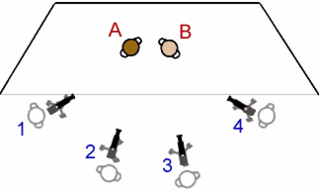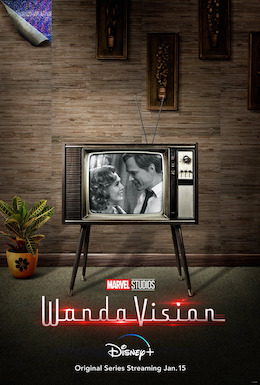
A point of view shot is a film scene—usually a short one—that is shot as if through the eyes of a character. The camera shows what the subject's eyes would see. It is usually established by being positioned between a shot of a character looking at something, and a shot showing the character's reaction. The POV technique is one of the foundations of film editing.

In film and video production, split screen is the visible division of the screen, traditionally in half, but also in several simultaneous images, rupturing the illusion that the screen's frame is a seamless view of reality, similar to that of the human eye. There may or may not be an explicit borderline. Until the arrival of digital technology, a split screen in films was accomplished by using an optical printer to combine two or more actions filmed separately by copying them onto the same negative, called the composite.
A teleplay is a screenplay or script used in the production of a scripted television program or series. In general usage, the term is most commonly seen in reference to a standalone production, such as a television film, a television play, or an episode of an anthology series. In internal industry usage, however, all television scripts are teleplays, although a "teleplay by" credit may be classified into a "written by" credit depending on the circumstances of its creation.

Cinematography is the art of motion picture photography.

A laugh track is an audio recording consisting of laughter usually used as a separate soundtrack for comedy productions. The laugh track may contain live audience reactions or artificial laughter made to be inserted into the show, or a combination of the two. The use of canned laughter to "sweeten" the laugh track was pioneered by American sound engineer Charles "Charley" Douglass.

A clapperboard, also known as a dumb slate, clapboard, film clapper, film slate, movie slate, or production slate, is a device used in filmmaking and video production to assist in synchronizing of picture and sound, and to designate and mark the various scenes and takes as they are filmed and audio-recorded. It is operated by the clapper loader. It is said to have been invented by Australian filmmaker F. W. Thring. Due to its ubiquity on film sets, the clapperboard is frequently featured in behind-the-scenes footage and films about filmmaking, and has become an enduring symbol of the film industry as a whole.
In photography, bracketing is the general technique of taking several shots of the same subject using different camera settings, typically with the aim of combining the images in postprocessing. Bracketing is useful and often recommended in situations that make it difficult to obtain a satisfactory image with a single shot, especially when a small variation in exposure parameters has a comparatively large effect on the resulting image. Given the time it takes to accomplish multiple shots, it is typically, but not always, used for static subjects. Autobracketing is a feature of many modern cameras. When set, it will automatically take several bracketed shots, rather than the photographer altering the settings by hand between each shot.
A cold open is a narrative technique used in television and films. It is the practice of jumping directly into a story at the beginning of the show before the title sequence or opening credits are shown. In North American television, this is often done on the theory that involving the audience in the plot as soon as possible will reduce the likelihood of their switching from a show during the opening commercial. A cold open may also be used to recap events in previous episodes or storylines that will be revisited during the current episode.
A take is a single continuous recorded performance. The term is used in film and music to denote and track the stages of production.
Video production is the process of producing video content for video. It is the equivalent of filmmaking, but with video recorded either as analog signals on videotape, digitally in video tape or as computer files stored on optical discs, hard drives, SSDs, magnetic tape or memory cards instead of film stock. There are three stages of video production: pre-production, production, and post-production. Pre-production involves all of the planning aspects of the video production process before filming begins. This includes scriptwriting, scheduling, logistics, and other administrative duties. Production is the phase of video production which captures the video content and involves filming the subject(s) of the video. Post-production is the action of selectively combining those video clips through video editing into a finished product that tells a story or communicates a message in either a live event setting, or after an event has occurred (post-production).
Television crew positions are derived from those of film crew, but with several differences.
This article contains a list of cinematic techniques that are divided into categories and briefly described.

A front projection effect is an in-camera visual effects process in film production for combining foreground performance with pre-filmed background footage. In contrast to rear projection, which projects footage onto a screen from behind the performers, front projection projects the pre-filmed material over the performers and onto a highly reflective background surface.

Virtual cinematography is the set of cinematographic techniques performed in a computer graphics environment. It includes a wide variety of subjects like photographing real objects, often with stereo or multi-camera setup, for the purpose of recreating them as three-dimensional objects and algorithms for the automated creation of real and simulated camera angles. Virtual cinematography can be used to shoot scenes from otherwise impossible camera angles, create the photography of animated films, and manipulate the appearance of computer-generated effects.

The multiple-camera setup, multiple-camera mode of production, multi-camera or simply multicam is a method of filmmaking and video production. Several cameras—either film or professional video cameras—are employed on the set and simultaneously record or broadcast a scene. It is often contrasted with a single-camera setup, which uses one camera.

Conversations with Other Women is a 2005 romantic drama film directed by Hans Canosa, written by Gabrielle Zevin, starring Aaron Eckhart and Helena Bonham Carter. The film won Best Actress for Bonham Carter at the 2005 Tokyo International Film Festival.
A sitcom is a genre of comedy centred on a fixed set of characters who mostly carry over from episode to episode. Sitcoms can be contrasted with sketch comedy, where a troupe may use new characters in each sketch, and stand-up comedy, where a comedian tells jokes and stories to an audience. Sitcoms originated in radio, but today are found mostly on television as one of its dominant narrative forms.
This glossary of motion picture terms is a list of definitions of terms and concepts related to motion pictures, filmmaking, cinematography, and the film industry in general.

"Filmed Before a Live Studio Audience" is the first episode of the American television miniseries WandaVision, based on Marvel Comics featuring the characters Wanda Maximoff / Scarlet Witch and Vision. It follows the newlywed couple as they try to conceal their powers while living an idyllic suburban life in the town of Westview, New Jersey. The episode is set in the Marvel Cinematic Universe (MCU), sharing continuity with the films of the franchise. It was written by head writer Jac Schaeffer and directed by Matt Shakman.










